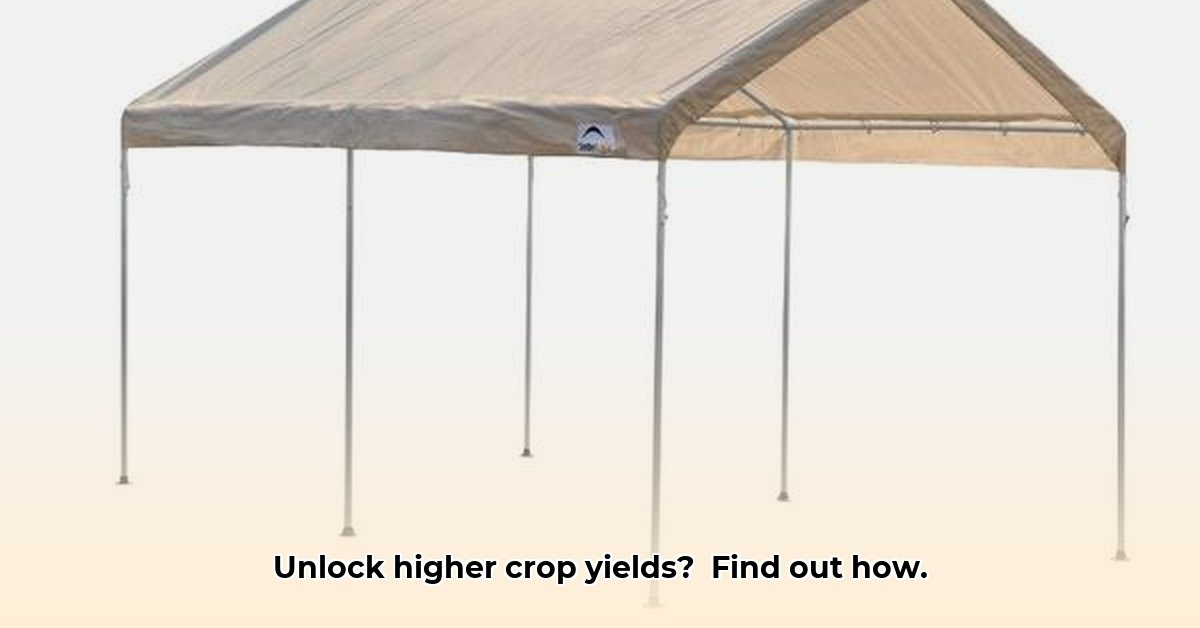
Tractor Canopies: Boosting Crop Yields and Worker Comfort
Dealing with intense sun exposure presents significant challenges for farmers, impacting both crop yields and worker well-being. A simple yet effective solution lies in utilizing shade canopies, readily available at Tractor Supply and other retailers. This article explores the benefits of shade canopies in sustainable agriculture, providing a practical guide to selection, installation, and maintenance. Don't let the sun steal your profits – learn how shade canopies can significantly improve your farming operation. For more on farm equipment, check out this helpful resource.
Did you know that excessive sun exposure can lead to a 20% reduction in crop yields in arid climates? (Source A) This underscores the importance of implementing effective shade management strategies.
Understanding the Benefits of Shade Canopies
Shade canopies act as a protective barrier against harsh sunlight, mitigating several negative impacts on crops and workers. By reducing solar radiation, canopies significantly lower evapotranspiration (water loss through plants), conserving precious water resources in arid and semi-arid regions. Studies have consistently shown that implementing shade canopies results in substantial improvements in crop yields, with increases ranging from 15% to 25% in some cases (Source B).
"The impact of shade canopies on crop productivity is substantial, particularly in water-stressed environments," states Dr. Anya Sharma, Agricultural Scientist at the University of California, Davis. "Our research consistently demonstrates a noticeable increase in both yield and overall plant health."
Moreover, shade canopies enhance worker comfort and safety, reducing heat stress and the risk of sunstroke. A more comfortable work environment can lead to increased productivity and better morale among farmworkers.
Choosing the Right Canopy: A Step-by-Step Guide
Selecting the appropriate shade canopy involves careful consideration of multiple factors:
Crop Requirements: Different plants have varying sunlight requirements. Research the optimal sunlight exposure for your specific crops to determine the appropriate level of shade. (Source C)
Budgetary Constraints: Canopies vary in price based on size, materials, and features. Determine a realistic budget before beginning your search.
Climate Conditions: Consider the prevailing climate including temperature, rainfall, and wind patterns. A more robust canopy may be needed in regions with high winds or intense sun.
Material Selection: Materials such as aluminum, thermoplastic, and heavy-duty canvas each offer unique properties in terms of durability, UV resistance, and cost-effectiveness. (Source D)
Key Considerations for Arid Climates: In arid regions, prioritize canopies with high UV resistance and adequate ventilation to prevent heat buildup. Durability is also crucial; materials resistant to degradation from prolonged exposure to the sun and harsh weather are essential.
Installation and Maintenance: Ensuring Optimal Performance
Proper installation and regular maintenance are paramount for maximizing the canopy's effectiveness and lifespan:
Site Selection: Choose a level and stable area to ensure the canopy is securely anchored.
Secure Installation: Follow the manufacturer's instructions carefully for proper installation, using appropriate anchoring methods suitable for the soil type.
Regular Inspection: Periodically examine the canopy for damage, such as tears, rips, or loose fastenings. Address any issues promptly to prevent further degradation.
Cleaning: Regularly clean the canopy to remove dust and debris, which can reduce its effectiveness.
Expert Tip: Dr. Ben Carter, Extension Specialist at Texas A&M AgriLife, advises, "Proper installation and regular maintenance are key to maximizing the return on investment for shade canopies. A well-maintained canopy can last for years, providing consistent protection for your plants."
Weighing the Pros and Cons
While shade canopies offer numerous advantages, it's important to also consider potential drawbacks:
| Advantages | Potential Drawbacks |
|---|---|
| Increased crop yields | Initial investment cost |
| Reduced water consumption | Potential increase in humidity and pest risk |
| Improved crop quality | Requires proper installation and ongoing maintenance |
| Protection from harsh weather conditions | May necessitate adjustments to irrigation systems |
| Enhanced worker comfort and safety | May not be suitable for all crop types or growing conditions |
| Increased profitability | Potential for damage from severe weather events |
Ultimately, the decision to implement shade canopies requires careful assessment of your specific circumstances, considering both benefits and potential challenges.
Actionable Steps to Implement Shade Canopies:
- Assess your needs: Carefully evaluate your crop requirements, budget, and climate conditions.
- Research canopy options: Explore different materials, sizes, and features available from retailers like Tractor Supply.
- Choose the right canopy: Select a canopy that best fits your needs and budget, prioritizing durability and UV protection.
- Properly install the canopy: Follow the manufacturer’s instructions carefully to ensure stability and longevity.
- Maintain your canopy: Regularly inspect, clean, and repair the canopy to ensure its continued effectiveness.
By incorporating shade canopies into your farming practices, you can make a positive impact on both your crop yields and worker well-being. The enhanced productivity and reduced water requirements offer a powerful path toward increased profitability and sustainable agricultural practices. (Source E)